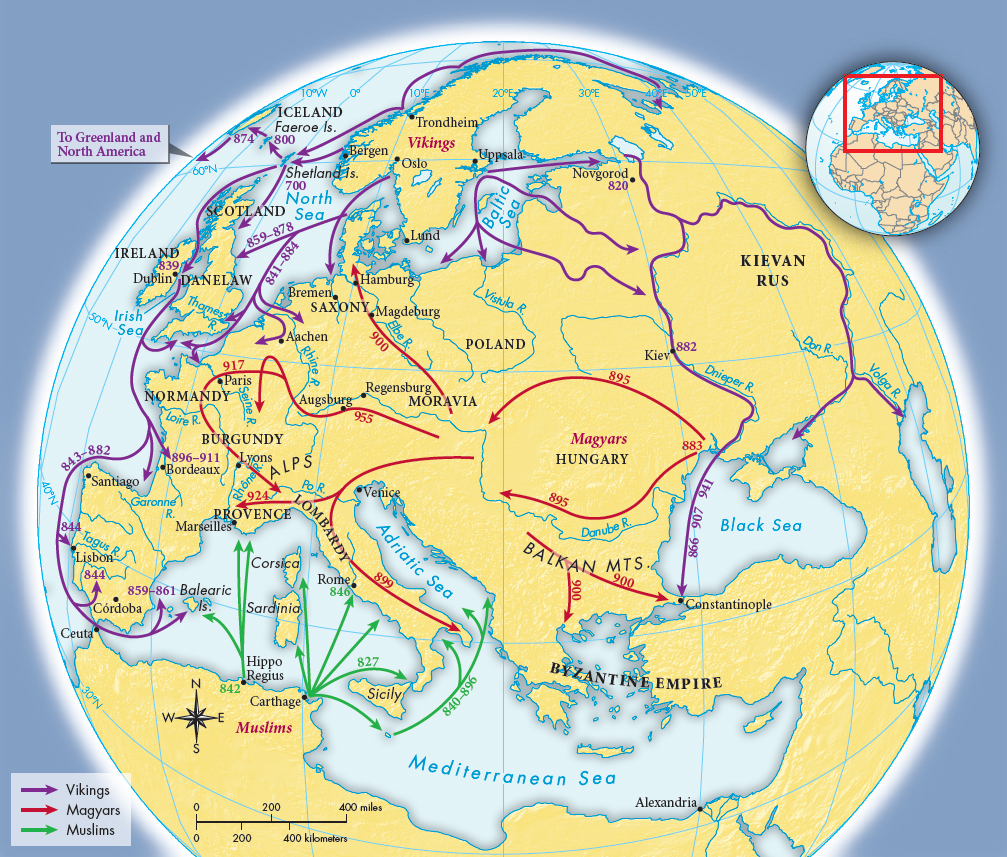A History of World Societies:
Printed Page 393
A History of World Societies Value
Edition: Printed Page 388
Chapter Chronology
Invasions and Migrations
From the moors of Scotland to the mountains of Sicily, there arose in the ninth century the prayer “Save us, O God, from the violence of the Northmen.” The feared Northmen were pagan Germanic peoples from Norway, Sweden, and Denmark who came to be known as Vikings. They began to make overseas expeditions, which they themselves called vikings, and the word came to be used for people who went on such voyages as well.
Viking assaults began around 800, and by the mid-tenth century the Vikings had brought large sections of continental Europe and Britain under their sway. In the east they sailed the rivers of Russia as far as the Black Sea. In the west they established permanent settlements in Iceland and short-lived ones in Greenland and Newfoundland in Canada (Map 14.1).

Mapping the PastMAP 14.1 Invasions and Migrations of the Ninth and Tenth Centuries This map shows the Viking, Magyar, and Muslim invasions and migrations in the ninth and tenth centuries. Compare it with Map 8.2 on the barbarian migrations of late antiquity to answer the following questions.ANALYZING THE MAP What similarities do you see in the patterns of migration in these two periods? What significant differences?CONNECTIONS How did the Vikings’ expertise in shipbuilding and sailing make their migrations different from those of earlier Germanic tribes? How did this set them apart from the Magyar and Muslim invaders of the ninth century?
The Vikings were superb seamen with advanced methods of boatbuilding. Propelled either by oars or by sails, deckless, and about sixty-five feet long, a Viking ship could carry between forty and sixty men — enough to harass an isolated monastery or village. Against these ships navigated by experienced and fearless sailors, the Carolingian Empire, with no navy, was helpless. At first the Vikings attacked and sailed off laden with booty. Later, on returning, they settled down and colonized the areas they had conquered, often marrying local women and adopting the local languages and some of the customs.
Along with the Vikings, groups of central European steppe peoples known as Magyars (MAG-yahrz) also raided villages in the late ninth century, taking plunder and captives and forcing leaders to pay tribute in an effort to prevent further destruction. Moving westward, small bands of Magyars on horseback reached far into Europe. They subdued northern Italy, compelled Bavaria and Saxony to pay tribute, and penetrated into the Rhineland and Burgundy. Western Europeans thought of them as returning Huns, so the Magyars came to be known as Hungarians. They settled in the area that is now Hungary, became Christian, and in the eleventh century allied with the papacy.
From North Africa, the Muslims also began new encroachments in the ninth century. They already ruled most of Spain and now conquered Sicily, driving northward into central Italy and the south coast of France.
From the perspective of those living in what had been Charlemagne’s empire, Viking, Magyar, and Muslim attacks contributed to increasing disorder and violence. Italian, French, and English sources often describe this period as one of terror and chaos. People in other parts of Europe might have had a different opinion. In Muslim Spain and Sicily scholars worked in thriving cities, and new crops such as cotton and sugar enhanced ordinary people’s lives. In eastern Europe states such as Moravia and Hungary became strong kingdoms. A Viking point of view might be the most positive, for by 1100 descendants of the Vikings not only ruled their homelands in Norway, Sweden, and Denmark but also ruled northern France (a province known as Normandy, or land of the Northmen), England, Sicily, Iceland, and Russia, with an outpost in Greenland and occasional voyages to North America.
